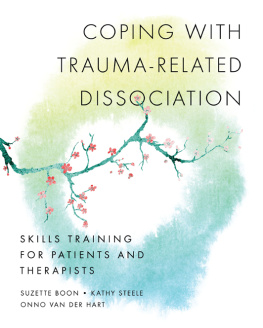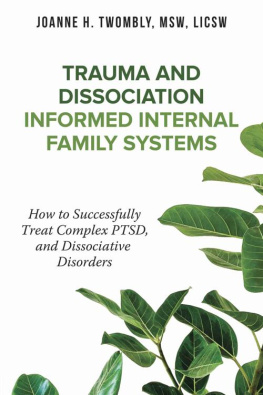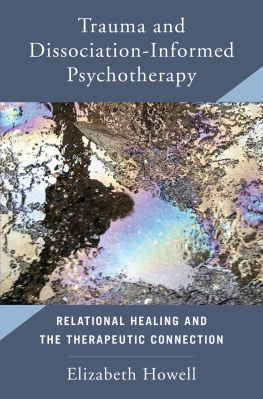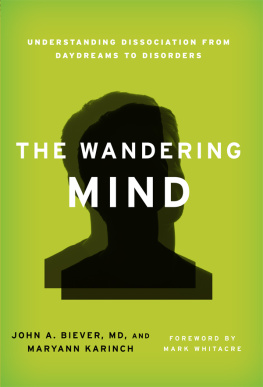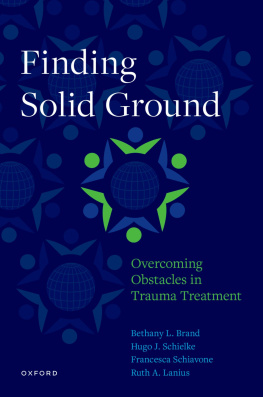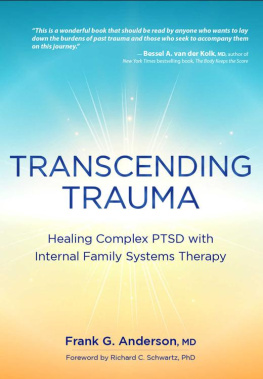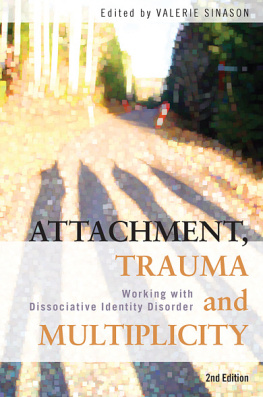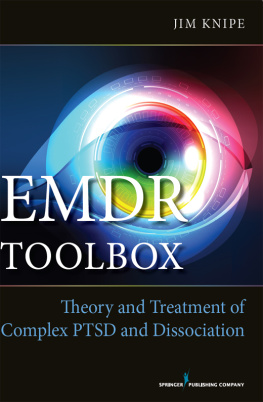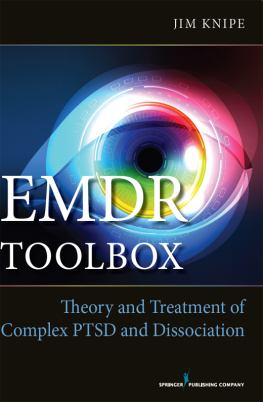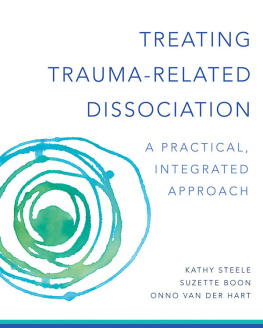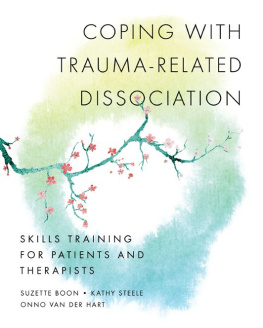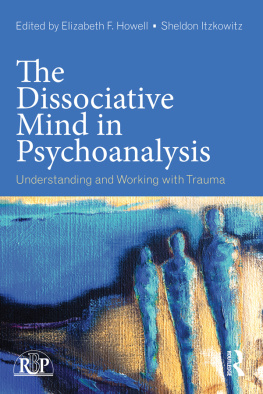
Coping With
Trauma-Related Dissociation
Skills Training for Patients
and Their Therapists
SUZETTE BOON
KATHY STEELE
ONNO VAN DER HART

W. W. NORTON & COMPANY
New York London
A NORTON PROFESSIONAL BOOK
This e-book contains some places that ask the reader to fill in questions or comments. Please keep pen and paper handy as you read this e-book so that you can complete the exercises within.
Many of our colleagues have made significant contributions to this manual, both through other training groups they have developed, and in offering ideas and suggestions. We especially mention Nel Draijer, Ethy Dorrepaal, and Kathleen Thomaes, who inspired us with their Stabilization Course, Vroeger and Verder, to develop this skills training. The teams and colleagues in the Netherlands who work with one of the authors (S.B.) have been invaluable in making contributions to the treatment of complex dissociative disorders and developing skills-training techniques. We would like to give special thanks to Sheri Miller, LCSW, and Kate OMullan, BA, for their helpful contributions to , Coping with Isolation and Loneliness. We would like to thank Jolanda Treffers for her excellent preface for patients from the perspective of a survivor. She originally wrote this for our Dutch translation. We are glad that her text now will be included in all future translations and reprints.
Most of all, we would like to thank our patients, who had the courage to share themselves with us, who have worked tirelessly for healing, and who are our most important inspiration for the manual. Many participants of the courses run in The Netherlands in the past 6 years, as well as several in the United States, provided invaluable comments on earlier versions of the manual, thus helping us improve it. We are very grateful for your suggestions and comments.
This manual contains many techniques. It is impossible to trace the origin of some long-standing techniques, because they have often come from an oral history of psychotherapy traditions, and some are ubiquitous. We have done our best to credit those techniques, and we apologize if we have unintentionally failed to cite sources.
APPENDIX A
DSM-IV Diagnostic Criteria
Dissociative Identity Disorder (DID)
A. The presence of two or more distinct identities or personality states (each with its own relatively enduring pattern of perceiving, relating to, and thinking about the environment and self).
B. At least two of these identities or personality states recurrently take control of the persons behavior.
C. Inability to recall personal information that is too extensive to be explained by ordinary forgetfulness.
D. The disturbance is not due to the direct physiological effects of a substance (e.g., blackouts or chaotic behavior during Alcohol Intoxication) or a general medical condition (e.g., complex partial seizures). Note: In children, the symptoms are not attributable to imaginary playmates or other fantasy play. (APA, 1994, p. 487)
Dissociative Disorder Not Otherwise Specified (DDNOS), Subtype 1b
This category is included for disorders in which the predominant feature is a dissociative symptom (i.e., a disruption in the usually integrated functions of consciousness, memory, identity, or perception of the environment) that does not meet the criteria for any specific dissociative disorder. DDNOS, Subtype 1b is described as follows:
1. Clinical presentations similar to Dissociative Identity Disorder that fail to meet full criteria for this disorder. Examples include presentations in which a) there are not two or more distinct personality states, or b) amnesia for personal information does not occur [italics added]. (APA, 1994, p. 490)
Posttraumatic Stress Disorder (PTSD)
A. The person has been exposed to a traumatic event in which both of the following were present:
(1) the person experienced, witnessed, or was confronted with an event or events that involved actual or threatened death or serious injury, or a threat to the physical integrity of self or others
(2) the persons response involved intense fear, helplessness, or horror. Note: In children, this may be expressed instead by disorganized or agitated behavior.
B. The traumatic event is persistently reexperienced in one (or more) of the following ways:
(1) recurrent and intrusive distressing recollections of the event, including images, thoughts, or perceptions. Note: In young children, repetitive play may occur in which themes or aspects of the trauma are expressed.
(2) recurrent distressing dreams of the event. Note: In children, there may be frightening dreams without recognizable content.
(3) acting or feeling as if the traumatic event were recurring (includes a sense of reliving the experience, illusions, hallucinations, and dissociative flashback episodes, including those that occur on awakening or when intoxicated). Note: In young children, trauma-specific reenactment may occur.
(4) intense psychological distress at exposure to internal or external cues that symbolize or resemble an aspect of the traumatic event
(5) physiological reactivity on exposure to internal or external cues that symbolize or resemble an aspect of the traumatic event
C. Persistent avoidance of stimuli associated with the trauma and numbing of general responsiveness (not present before the trauma), as indicated by three (or more) of the following:
(1) efforts to avoid thoughts, feelings, or conversations associated with the trauma
(2) efforts to avoid activities, places, or people that arouse recollections of the trauma
(3) inability to recall an important aspect of the trauma
(4) markedly diminished interest or participation in significant activities
(5) feeling of detachment or estrangement from others
(6) restricted range of affect (e.g., unable to have loving feelings)
(7) sense of a foreshortened future (e.g., does not expect to have a career, marriage, children, or a normal life span)
D. Persistent symptoms of increased arousal (not present before the trauma), as indicated by two (or more) of the following:
(1) difficulty falling or staying asleep
(2) irritability or outbursts of anger
(3) difficulty concentrating
(4) hypervigilance
(5) exaggerated startle response
E. Duration of the disturbance (symptoms in Criteria B, C, and D) is more than 1 month.
F. The disturbance causes clinically significant distress or impairment in social, occupational, or other important areas of functioning. (APA, 1994, pp. 427429)
Complex Posttraumatic Stress Disorder (CPTSD) or
Disorders of Extreme Stress Not Otherwise Specified (DESNOS)
This proposed disorder is not included in the DSM-IV. However, some of its symptoms are included in the DSM-IV under Associated descriptive features and mental disorders of PTSD (APA, 1994). The DSM-IV states that this constellation of symptoms may occur and are more commonly seen in association with an interpersonal stressor (e.g., childhood sexual abuse or physical abuse, domestic battering, being taken hostage, incarceration as a prisoner of war or in a concentration camp, torture) (APA, 1994, p. 435).
A. Alterations in regulating affective arousal
(1) chronic affect dysregulation
(2) difficulty modulating anger
(3) self-destructive and suicidal behavior
(4) difficulty modulating sexual involvement
(5) impulsive and risk-taking behaviors
Next page
